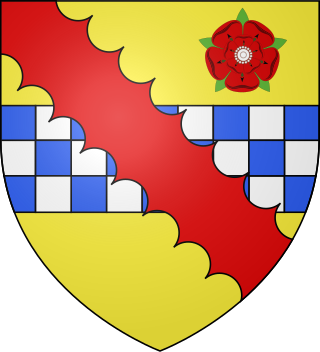Related Research Articles

Walter Stewart, 1st Lord Blantyre was a Scottish courtier, politician and judge. Educated with James VI under George Buchanan at Stirling Castle, he was a gentleman in the king's chamber, Knight of Cardonald, Prior of Blantyre, Keeper of the Privy Seal of Scotland from 1582 to 1596, an Extraordinary Lord of Session from 1593, an Octavian from 1596, and Treasurer of Scotland from 1596 to 1599
Sir William Stewart of Houston was a Scottish soldier, politician and diplomat.

Adrian Vanson was a portrait artist who worked for James VI of Scotland.
Sir Richard Cockburn of Clerkington, Lord Clerkintoun (1565–1627) was a senior government official in Scotland serving as Lord Privy Seal of Scotland during the reign of James VI.
Jean Fleming, Countess of Cassilis (1553/4–1609) was a Scottish noblewoman and courtier at the court of James VI of Scotland, and a survivor of domestic violence.
Thomas Foulis was a Scottish goldsmith, mine entrepreneur, and royal financier.
Nicholas (Nicol) Uddert or Udward or Udwart or Anglicised as Nicol Edward was a 16th century Scottish merchant who served as Provost of Edinburgh in 1592/93.
George Young was a Scottish churchman, courtier, member of the Privy Council of Scotland, diplomat, and secretary depute.

Claude de l'Isle de Marivaux was a French diplomat working for Henry of Navarre.
Sir William Keith of Delny was a Scottish courtier and Master of the Royal Wardrobe. He also served as ambassador for James VI to various countries. He was an important intermediary between George Keith, 5th Earl Marischal and the king, the king and courtiers, and the king and foreign governments.
William Stewart was a Scottish courtier.

Jacques de Bousie was a Flemish confectioner known as a "sugarman" working in Edinburgh, Scotland, employed by James VI and Anne of Denmark.
Robert Jameson was a Scottish shipowner from Ayr.

Queen Elizabeth I of England paid a subsidy to King James VI of Scotland from 1586 to 1602. This enabled her to influence James by delaying or deferring payments to his diplomats in London. Records survive of the yearly amounts, and details of the expenditure in some years. A large proportion of the money was spent on the royal wardrobe of James and Anne of Denmark. Some royal expenses were met by Anne of Denmark's dowry, which was known as the "tocher". The regular incomes of the Scottish crown were feudal rents, customs, and "compositions" charged on grants of land. Accounts for royal incomes and payments survive as the exchequer rolls and lord treasurer's accounts and have been published as historical sources.
William Fairlie or Fairley was an Edinburgh merchant and burgess.
David Carnegie of Colluthie (1559–1598) was a Scottish landowner and administrator.
Alexander Hay of Easter Kennet was a Scottish lawyer and politician.

William Stewart of Grandtully (1567–1646) was a Scottish landowner and courtier.
Mungo Graham of Rathernis was a Scottish landowner and courtier.

Alexander Oustean or Oustian or Austin was a Scottish tailor and member of Edinburgh burgh council.
References
- ↑ James David Marwick, Extracts from the Records of the Burgh of Edinburgh, 1573-1579 (Edinburgh, 1882), pp. 113-4.
- ↑ Calendar State Papers Scotland: 1574–1581, vol. 5 (Edinburgh, 1907), p. 357.
- ↑ Documents relative to the reception at Edinburgh of the Kings and Queens of Scotland, 1561–1650 (Edinburgh, 1822), pp. 12–14.
- ↑ Jean Munro & Henry Steuart Fotheringham, Edinburgh Goldsmith's Minutes: 1525–1700 (SRS: Edinburgh, 2006), p. 227.
- ↑ Miles Kerr-Peterson & Michael Pearce, 'James VI's English Subsidy and Danish Dowry Accounts, 1588-1596', Scottish History Society Miscellany XVI (Woodbridge, 2020), p. 64.
- ↑ Miles Kerr-Peterson & Michael Pearce, 'James VI's English Subsidy and Danish Dowry Accounts, 1588-1596', Scottish History Society Miscellany XVI (Woodbridge, 2020), p. 64.
- ↑ Marguerite Wood, Extracts from the Burgh Records of Edinburgh, 1589–1603 (Edinburgh, 1927), p. 53.
- ↑ David Masson, Register of the Privy Council, 1599-1604, vol. 6 (Edinburgh, 1884), p. 195.